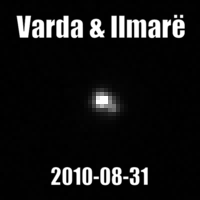Not to be confused with 2107 Ilmari.
 Hubble Space Telescope image of Varda and its satellite Ilmarë, taken in 2010 and 2011 Hubble Space Telescope image of Varda and its satellite Ilmarë, taken in 2010 and 2011 | |
| Discovery | |
|---|---|
| Discovered by | Keith S. Noll et al. |
| Discovery date | 2009, based on images taken on 26 April 2009 |
| Designations | |
| Designation | Varda I |
| Pronunciation | /ˈɪlməriː/ |
| Named after | Ilmarë (figure by J. R. R. Tolkien) |
| Alternative names | 174567 Varda I Ilmarë |
| Adjectives | Ilmarëan /ɪlməˈriːən/ |
| Orbital characteristics | |
| Semi-major axis | 4809±39 km |
| Eccentricity | 0.0181±0.0045 or 0.0247±0.0048 (0.0215±0.0080 adopted) |
| Orbital period (sidereal) | 5.75058±0.00015 d |
| Inclination | 101.0±1.9 or 85.1±1.8 |
| Satellite of | Varda |
| Physical characteristics | |
| Mean diameter | ≈356 326+38 −34 km |
| Mass | ≈2.2×10 kg |
| Mean density | 1.24+0.50 −0.35 g/cm (system) |
| Albedo | ≈0.085 0.166+0.043 −0.033 (assuming same as Varda) |
| Spectral type | B−V = 0.857±0.061 V−I = 1.266±0.052 |
| Absolute magnitude (H) | 3.097±0.060 |
Ilmarë, or Varda I, full designation 174567 Varda I Ilmarë, is the single known natural satellite of the Kuiper belt object 174567 Varda. It was discovered by Keith Noll et al. in 2009, at a separation of about 0.12 arcsec, using discovery images taken by the Hubble Space Telescope on 26 April 2009, and reported in 2011. At approximately 326 km in diameter (about 45% that of its primary), it is the fourth or fifth-largest known moon of a trans-Neptunian object, after Pluto I Charon, Eris I Dysnomia, Orcus I Vanth and very possibly Haumea I Hiʻiaka. Assuming that Ilmarë has the same albedo and density as Varda, Ilmarë would constitute approximately 8.4% of the system's mass, approximately 2.2×10 kg.
Name
Names for Varda and its moon were announced on 16 January 2014. Ilmarë (Quenya: [ˈilmarɛ]) is a chief of the Maiar and handmaiden to Varda, the queen of the Valar, creator of the stars, and principal goddess of the elves in J. R. R. Tolkien's fictional mythology.
Characteristics
Ilmarë and Varda are tightly bound, with a separation of about 13 Varda radii, and a consequently low angular momentum. Along with the high inclination of Varda's orbit, they are similar in this way to the Orcus–Vanth and Salacia–Actaea systems. As of 2015 two mirror orbital solutions are possible with slightly different orbital parameters. The calculated eccentricity is inconsistent with the likely age of the system, suggesting that it might be spurious, but the expected age is also contradicted by suggestions that Varda may not be tidally locked.
If Ilmarë and Varda have the same albedo, Ilmarë would be 163+19
−17 km in radius, or approximately 8.4% the volume of Varda. If the two bodies also have the same density, Ilmarë would then have approximately 8.4% the system mass of (2.664±0.064)×10 kg.
If, however, the albedo of Varda is 50% greater than that of Ilmarë, Ilmarë would have a radius of 191+22
−21 km and the bulk density of the system would be 1.31+0.52
−0.36 g/cm. If Ilmarë has a 50%-greater albedo, then its radius would be 137+16
−15 km and the bulk density would be 1.18+0.47
−0.33 g/cm. Because the absolute magnitudes of the two bodies at different wavelengths are similar, it's not likely that their albedos differ by much, so Ilmarë is likely to be in this size range.
Notes
References
- ^ "174567 Varda (2003 MW12)". Minor Planet Center. Retrieved 5 June 2018.
- ^ Grundy, W. M.; Porter, S. B.; Benecchi, S. D.; Roe, H. G.; Noll, K. S.; Trujillo, C. A.; Thirouin, A.; Stansberry, J. A.; Barker, E.; Levison, H. F. (1 September 2015). "The mutual orbit, mass, and density of the large transneptunian binary system Varda and Ilmarë". Icarus. 257: 130–138. arXiv:1505.00510. Bibcode:2015Icar..257..130G. doi:10.1016/j.icarus.2015.04.036. S2CID 44546400.
- ^ Souami, D.; Braga-Ribas, F.; Sicardy, B.; Morgado, B.; Ortiz, J. L.; Desmars, J.; et al. (August 2020). "A multi-chord stellar occultation by the large trans-Neptunian object (174567) Varda". Astronomy & Astrophysics. 643: A125. arXiv:2008.04818. Bibcode:2020A&A...643A.125S. doi:10.1051/0004-6361/202038526. S2CID 221095753.
- Vilenius, E.; Kiss, C.; Mommert, M.; Müller, T.; Santos-Sanz, P.; Pal, A.; Stansberry, J.; Mueller, M.; Peixinho, N.; Fornasier, S.; Lellouch, E.; Delsanti, A.; Thirouin, A.; Ortiz, J. L.; Duffard, R.; Perna, D.; Szalai, N.; Protopapa, S.; Henry, F.; Hestroffer, D.; Rengel, M.; Dotto, E.; Hartogh, P. (4 May 2012). "'TNOs are Cool': A survey of the trans-Neptunian region". Astronomy & Astrophysics. 541: A94. arXiv:1204.0697. Bibcode:2012A&A...541A..94V. doi:10.1051/0004-6361/201118743. S2CID 54222700.
| Moons of likely dwarf planets | |||||||||||||
|---|---|---|---|---|---|---|---|---|---|---|---|---|---|
| |||||||||||||
| |||||||||||||

